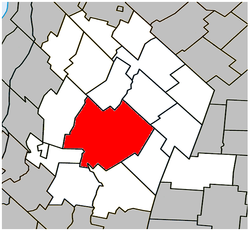Saint-Hyacinthe, Quebec
| Saint-Hyacinthe | ||
|---|---|---|
| City | ||

Parc Casimir-Dessaules.
|
||
|
||
 Location within Les Maskoutains RCM. |
||
| Location in southern Quebec. | ||
| Coordinates: 45°37′N 72°57′W / 45.617°N 72.950°WCoordinates: 45°37′N 72°57′W / 45.617°N 72.950°W | ||
| Country |
|
|
| Province |
|
|
| Region | Montérégie | |
| RCM | Les Maskoutains | |
| Founded | 1849 | |
| Constituted | 27 December 2001 | |
| Government | ||
| • Mayor | Claude Corbeil | |
| • Federal riding | Saint-Hyacinthe—Bagot | |
| • Prov. riding | Saint-Hyacinthe | |
| Area | ||
| • City | 191.60 km2 (73.98 sq mi) | |
| • Land | 188.69 km2 (72.85 sq mi) | |
| • Metro | 326.76 km2 (126.16 sq mi) | |
| Population (2011) | ||
| • City | 53,236 | |
| • Density | 282.1/km2 (731/sq mi) | |
| • Metro | 56,794 | |
| • Metro density | 173.8/km2 (450/sq mi) | |
| • Pop 2006-2011 |
|
|
| • Dwellings | 25,774 | |
| Time zone | EST (UTC−5) | |
| • Summer (DST) | EDT (UTC−4) | |
| Postal code(s) | J2S | |
| Area code(s) | 450 and 579 | |
| Highways |
|
|
| Website | Official website | |
Saint-Hyacinthe (/ˌseɪnt ˈhaɪəsɪnθ/; French: [sɛ̃tijasɛ̃t]) is a city in southwestern Quebec east of Montreal on the Yamaska River. The population as of the Canada 2011 Census was 53,236. The city is located in Les Maskoutains Regional County Municipality of the Montérégie region, and is traversed by the Yamaska River which flows perpendicular to Quebec Autoroute 20. Saint-Hyacinthe is the seat of the judicial district of the same name.
At the time of its establishment in 1849, the village of Saint-Hyacinthe had a population of 10,200. A year later it was made a town, and in 1857 it was made a city. The city is named for Saint Hyacinth.
As part of the 2000–2006 municipal reorganization in Quebec, on 27 December 2001, the city of Saint-Hyacinthe amalgamated with five neighbouring towns (listed here with their populations as of 2001):
Agriculture and its related derivates are at the heart of Saint-Hyacinthe's economic infrastructure. The city has been nicknamed the "Agricultural technopolis of Canada", because it is home to several research institutions in the field such as the centre de recherche sur les aliments (CRDA), the Institut de recherche et développement en agro-environnement (IRDA), the institut de technologie agroalimentaire (ITA) and the head office of the Artificial Insemination Center of Quebec (CIAQ).
...
Wikipedia


